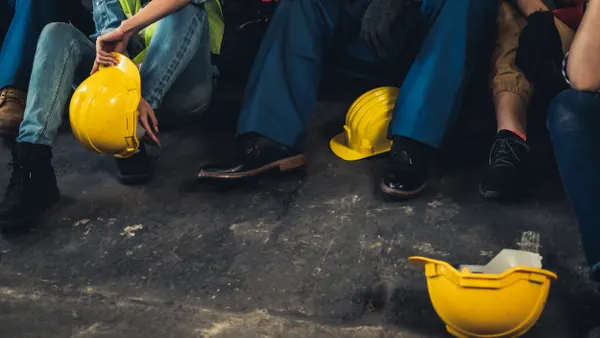As the United States continues to shed manufacturing jobs, a program designed to support laid off workers may be changing.
One significant source of federal support comes through the U.S. Department of Labor’s Employment Recovery Dislocated Worker Grants, which offer funding to eligible agencies or organizations responding to major economic dislocations such as layoffs or plant closures.
This past March, the Labor Department rescinded $75 million from a $200 million advance to the Dislocated Worker National Reserve as part of a continuing resolution to extend government funding through the end of the 2025 fiscal year. The reserve totaled $301 million in 2024. While this didn’t affect the agency’s authority to award future DWG grants, it still posed a significant reduction in potential funding. Meanwhile, Congress is also considering future changes to the program to align it with the Trump administration’s priorities.
The Texas Workforce Commission, which received a $1 million DWG grant last year, said the results were undeniably positive.
“The National Dislocated Worker Grant program has demonstrably impacted the lives of its participants, facilitating career advancements and increased stability for workers in a variety of industries, including those impacted by the reported layoffs,” said Matthew Mazer, an information specialist at the Texas Workforce Commission, via email.
Some labor experts, however, contest the efficacy of such programs.
“The closer you look at these programs, both at how they function on the ground and at the discussions around their funding and operation, the clearer it becomes that the true function of these programs is not economic — i.e. not to get new jobs for laid-off workers — but political, for both employers and elected officials,” said Gordon Lafer, a professor at the University of Oregon's Labor Education and Research Center, via email.
A 2020 study from the Government Accountability Office cited an inability to effectively assess the impact of job training offered under this and other related programs “due to methodological challenges.”
“By collecting more quality evidence, DOL could be better able to determine if its [economic adjustment assistance] programs are helping workers achieve their employment goals,” said the study.
Origins of the WIOA
The DWGs were most recently authorized under the Workforce Innovation and Opportunity Act in 2014, but the idea of federal grants for dislocated workers dates back to at least the ‘80s.
The Job Training Partnership Act of 1982 helped states respond to layoffs and factory closures. That was followed-up by the Workforce Investment Act of 1998, which the WIOA reauthorized and updated to emphasize industry-supported certificates and partnerships with local employers.
Today, the WIOA’s employment and training services are triggered following a qualifying dislocation event such as a mass layoff, plant closure, community impact event, or higher-than-average demand for employment and training activities for dislocated members of the Armed Forces and their spouses.
The grants are, in theory, a way to quickly disperse funds for training and career services to affected states.
The Texas Workforce Commission leaned into DWG funds, for instance, following a mass layoff of 2,700 people at the Tesla Gigafactory in Austin.
“The Capital Area and Rural Capital Area Workforce Development Boards lacked sufficient funding, as the anticipated number of dislocated workers exceeded the capacity of the boards’ available formula funds,” said Mazer.
TWC subsequently applied for the grant to bolster assistance efforts and address the increased demand for workforce services within the area. Funds were available within four weeks of their grant award, Mazer said, and were applied toward “employment and training assistance activities” such as “career services, training services and supportive services.”
In Washington, the state’s Employment Security Department was awarded $2 million in April to support Boeing’s 2,000 laid-off workers.
During the first quarter of operation, funds went towards “subcontracting with local workforce development boards in Snohomish and King counties, developing business and outreach plans, [and] planning how services would be delivered and coordinating at WorkSource offices to support people impacted by the layoffs,” said a spokesperson for the ESD.
Later in July, the DOL announced a grant of $1.8 million to the Technical College System of Georgia to support employment and training services for hundreds of people affected by layoffs at a Georgia-Pacific containerboard mill.
According to Lafer, the size of the funds hides their more limited scale.
“There were about 2,700 people laid off [at the Tesla Gigafactory], so if they all enrolled in this program there might be $370 for each person,” said Lafer, noting this was likely lower due to overhead costs. “To teach someone a true occupational trade — say, being a long-haul truck driver, or a tool and die maker, or an electrician — typically costs more than 10 times this amount.”
According to Lafer, even $1,000 per person may be “just enough to put them through a few workshops about how to write a resume or look for a job, or very superficial training.”
Indeed, in addition to Dislocated Worker Grants, the Texas Workforce Commission attributed its local recovery partly to “Texas’ strong economy, [which] continued to grow and generate new opportunities for workers in the manufacturing industry.”
The future of Dislocated Worker Grants
The Senate’s proposed appropriations for FY 2026 suggest consolidating 11 DOL workforce development programs, including the DWG grants, into a single Make America Skilled Again grant program.
“Many of the existing programs have mixed records of effectiveness, and others have never been formally evaluated,” the proposed bill states. “The MASA grant program gives states and localities the flexibility to respond to their workforce needs in a way that makes sense without having to apply for and manage multiple federal programs.”
In response, the National Skills Coalition suggested that merging 11 programs into one block grant “risks losing those tailored supports, making it harder for people to access training that fits their lives and needs.”
However, in the view of some such as Lafer, initiatives such as the DWG grants are still insufficient.
”No one is coming out of that with what anyone would call a new trade or profession,” he said, adding that the only way to effectively support dislocated workers is to focus on “not training, but job creation.”




















